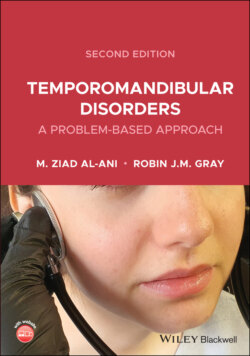Читать книгу Temporomandibular Disorders - Robin J. M. Gray - Страница 21
The intra‐articular disc (meniscus)
ОглавлениеAbout 55 years ago, Rees described the intra‐articular disc as being like a ‘school‐boy’s cap'. It is an oval‐shaped tense sheet of fibrous tissue with a concave inferior surface sitting on the head of the condyle (Figure 2.6). On its posterior aspect, it has a convex upper surface; it becomes saddle‐shaped on its anterior aspect. It overlays the condylar head and blends medially and laterally with the capsule. It is also attached to the medial and lateral poles of the condyle and anteriorly to the superior pterygoid muscle. This structural arrangement, as it is interposed between the head of the condyle and the glenoid fossa, divides the joint into the upper and lower joint spaces (Figure 2.7).
Figure 2.6 Diagram of disc morphology.
(Rees LA. The structure and function of the mandibular joint. J Br Dent Assoc 1954; XCVI:126–33.)
Figure 2.7 Sagittal section of porcine temporomandibular joint. As in human beings, the articular surface of the mandibular condyle is convex and joins the lower articular surface of the meniscus, which is concave, to form a condylomeniscal joint.
(M. Ziad Al‐Ani, Robin J.M. Gray.)
There are four zones of the disc:
1 The anterior band which is of moderate thickness but narrow in an anteroposterior direction.
2 The intermediate band, which is the thinnest zone of the disc.
3 The posterior band, which is both the thickest and the widest transverse zone of the disc.
4 The bilaminar zone, which consists of two parts: the superior band, which is attached to the posterior wall of the glenoid fossa and squamotympanic fissure and is elastic, and the inferior band, which is attached to the neck of the condyle and is fibrous.
The disc is attached anteriorly to the margin of the articular eminence superiorly and to the articular margin of the condyle inferiorly. Posteriorly, the disc is attached to the glenoid fossa and squamotympanic fissure (elastic attachment) and to the distal aspect of the neck of the condyle (fibrous attachment). This is termed the ‘posterior bilaminar zone’. Medially and laterally the meniscus blends with the capsule. The disc is also attached to adjacent muscles, namely the lateral pterygoid (anteriorly) and masseter and temporalis muscles (laterally). The fibres of the lateral pterygoid muscle merge with the disc anteriorly to form its true insertion. The connections with the masseter and temporalis muscles are less strong, consisting of fibrous bands of thickened tissue at right angles to the direction of the muscle fibres.
This varying thickness of the bands in the disc is significant when considering the functional anatomy of the joint. The meniscus is flexible and able to alter shape to concave or convex during forward movement of the condyle, because of the thinner intermediate zone between the two thicker anterior and posterior zones.
In the “at rest” mandibular position, the condyle is separated from the temporal bone by the thick posterior band. As the head of the condyle moves forward towards the articular eminence, it is separated from the temporal bone by the thinner intermediate zone and, as anterior movement progresses, the head of the condyle continues to move forwards until it is resting on the thicker but narrow anterior band.
During mouth opening, the disc moves forwards but not to the same extent or with the same speed as the head of the condyle. The forward movement of the meniscus is permitted by the loose fibroelastic tissue of the bilaminar zone, which is stretchable to 7–10 mm. In addition, the structures of the bilaminar zone are ideally suited to filling the void of the vacated glenoid fossa when the condyle is in a protrusive position.
The non‐elastic lower band attached to the posterior neck of the condyle contributes to the return of the meniscus during retrusion of the mandible. This is helped by the elastic recoil of the upper attachment.
The disc acts as a ‘shock absorber’ during masticatory function. The central part of the disc is mainly avascular and depends on nutrition from diffusion from the synovial fluid. A rich vascular plexus is, however, present in the posterior part of the bilaminar zone which is mainly supplied from the deep auricular artery, a branch of the internal maxillary artery. Although the central part of the meniscus is poorly innervated, the bilaminar zone has a dense innervation from a branch of the auricular temporal nerve, the masseteric nerve and the posterior deep temporal nerve.
It has been suggested that the articular disc has many functions which may include shock absorption, increasing congruity between the articular surfaces, allowing combinations of different movements at the joint, ball‐bearing action, force distribution by increasing the contact area between articular surfaces, providing stability during mandibular movements and playing a role in assisting joint lubrication by forming thin synovial fluid films.
